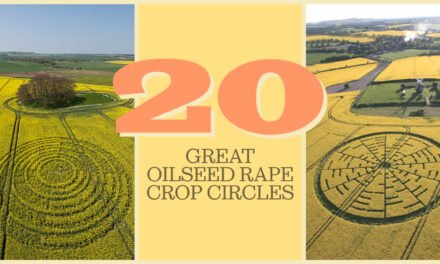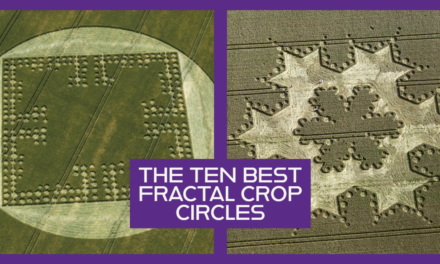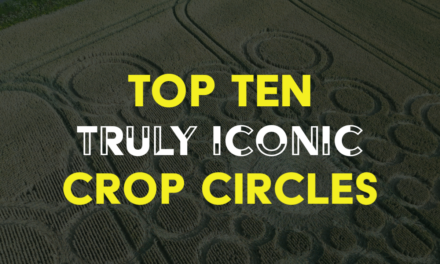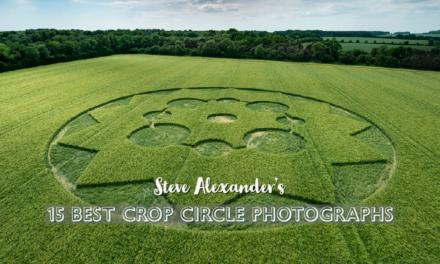
Ten More Epic Crop Circle Locations

We’ve already published a piece on Ten Epic Crop Circle Locations, but found ourselves frustrated whist putting things together. What about Barbury Castle? What about Hackpen Hill? And so it went on. There really are so many beautiful, enchanting and occasionally odd places where the crop circles have appeared that they more than merit this follow up. Let’s begin with the weirdest…
Woolaston Grange, Gloucestershire

Photograph by Olivier Morel
I remember pulling up a short distance off the A40, not far from the English-Welsh border, in the damp of a summer afternoon in 2010. In the drizzle I walked under a railway bridge and down onto the footpath that runs alongside the fields on the northern bank of the River Severn. Not only was there a crop circle at my feet, but also the looming, grey structure of the Oldbury Nuclear Power Station on the other side of the water. Through the drizzle, in a strong breeze, everything seemed to fit together. It isn’t somewhere you would expect to find a crop circle — and it’s always windy! — but even with the power station in the background, the bleak beauty and liminality of this place makes it stick in the memory.
Devil's Den, Wiltshire

Photograph by Steve Alexander
The Devil’s Den is the remain of a prehistoric dolmen (single room) burial chamber just off the A4 near Fyfield on the Marlborough Downs. The rather unstable looking structure was re-erected in 1921 and is held in place, as with many other clumsy pieces of early 20th century restoration work, with some unsightly pieces of concrete. Nonetheless, the real beauty of the Devil’s Den isn’t the dolmen, it’s the shallow, narrow valley that it occupies. Somehow, despite the busy road nearby, it is a location that is unnervingly quiet but for the sound of birds and the occasional tractor. It is beautiful at any time of year, particularly at sunset under a clear sky. Whilst the steep sides aren’t the most circle friendly, a handful of formations have appeared here through the years, much to the chargrin of the farmer who seems to be very quick to cut out any new arrivals.

The Devi’s Den 2018. Photograph by Nick Bull Photography
Roundway Down & Oliver's Castle, Wiltshire

The view on Roundway Down from a 2023 crop circle. Oliver’s Castle marks the edge of the scarp, with views to Melksham and Bath in the background. Photograph by Kris Malford.
Roundway Down is situated just to the north of Devizes and is one of those quiet, completely agricultural, attractive places where countless locals roam with their dogs during the daylight hours. The fields are long and secluded, making them a regular site for crop circles.
Nearby is the hillfort of Oliver’s Castle, presumably named after Oliver Cromwell due to the Civil War battle that took place close by. Indeed, in the confusion of their rout, parliamentary cavalry plunged over the edge of the deeply gullied scarp. This hillside is also familiar for featuring in the dream sequences of the British film adaptation of George Orwell’s novel 1984. Of course, croppies will remember a field under Oliver’s Castle as the setting for one of the biggest controversies in cerealogical history: the 1996 balls of light video.
Hackpen Hill, Wiltshire

Photograph by Crop Circle Explorer
To the south of Wroughton, the A461 climbs up onto the Marlborough Downs and the edge of the beautiful Barbury Estate. For much of the eight mile drive to Avebury, the road is overlooked from the east by a string of hills, topped by ancient path of The Ridgeway. The best known of these heights is Hackpen Hill and it is a location that is easy to fall for. The 19th century white horse and three tree clumps are familiar local landmarks, but that isn’t the reason people — and perhaps the crop circles — come here: the view to the western landscape is incredible, taking in Wroughton, the village of Broad Hinton and the area down towards Avebury and Calne. And, right under the hill, are some of the biggest arable fields in Wiltshire. If the circle makers want their work to be seen, there are few vantage points that provide a superior view.

Photograph by Nick Bull
Barbury Castle, Wiltshire

Photograph by Crop Circle Explorer
On the northern edge of the Marlborough Downs, five miles from Swindon, the ancient hillfort of Barbury Castle is a crop circle hotspot. Whilst the views to the north and north-west are always memorable, taking in part of the Cotswolds up to the River Severn, Barbury Castle just happens to be a fantastic vantage point to look down into some impressively large fields usually given over to circle friendly crops: oilseed rape, barley and wheat. Visitors really cannot miss anything that appears below them.

Photograph by Steve Alexander/Temporary Temples
Wilton Windmill, Wiltshire

Photograph by Tsfromthewastelands
A beautiful stone tower structure dating from 1821, Wilton Windmill sits on a hilltop not far from the Wiltshire-Hampshire border within the lovely North Wessex Downs. Having fallen into disrepair in the early 20th century, the structure was restored to its current — and working — state in the 1970s.
Appropriately, the windmill is surrounded by arable fields, one of which is rather flat and occasionally attracts crop circles. The best known of these appeared in 2010 and was said to be encoded with Euler’s Theorem, a mathematical formula.

The Euler’s Theorem crop circle from 2010 at Wilton Windmill. Photograph by Lucy Pringle
Wilmington, East Sussex

Photograph by Josie Campbell
Carved into the chalk surface of Windover Hill in East Sussex at some point in the 16th or 17th centuries, the Long Man depicts a figure that seems to be holding two very tall sticks. The carving looks over to the Priory, church, ancient yew tree, narrow lane and small collection of houses that make up the pretty village of Wilmington, a location popular with walkers and tourists alike. At the Long Man’s feet are a cluster of sizeable, undulating fields which seem a natural fit for the circles. Whilst a reasonable formation appeared close to the Long Man in 2014, a 2021 effort was less than impressive. It’s a shame that no photographs of either formation exist that do justice to this beautiful location, one best visited under the sun.
Danebury Hillfort, Hampshire

Danebury Hill at harvest time. Photograph by Hannah Kathleen
Another hillfort for the list, and the The Croppie‘s personal favourite. Situated on the downs above the pretty town of Stockbridge, Danebury Hill offers visitors gorgeous views over Charity Down, and the beautiful Hampshire countryside. Surrounded by agricultural land, it really is no wonder that the crop circles enjoy making sporadic visits to this stunning location.

Danebury Hillfort, 1 July 2019. Photograph by Nick Bull
Rollright Stones, Oxfordshire

Photograph by Hugh Newman / Crop Circles From the Air.
Who cannot fall in love with the Rollright Stones from the very first moment they set eyes upon The King’s Men, an ancient stone circle from the Late Neolithic or Early Bronze Age period?
Despite backing onto a minor road, the charm of the stones, rolling Cotswolds landscape and some well placed trees all mean you never feel part of the present. The stones are also slap-bang right next to a beautiful field that is sometimes given over to wheat crop.

That view … photograph by The Croppie.
Stonehenge, Wiltshire

Photography by Nick Bull
What hasn’t already been said about the greatness of Stonehenge, on the Salisbury Plain? It’s a location that is as magical in the hottest summer as it is the bleakest winter. Of course, numerous crop circles have appeared here through the years, the most important being 1996’s Julia Set.

Photograph by Steve Alexander
Sadly, the wheat field in which the Julia Set appeared is no more. The National Trust have taken over stewardship of this and some of the adjacent fields and are reverting them to grassland. That’s a real shame if you’re a croppie.





